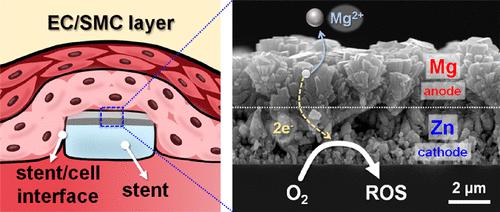Our official English website, www.x-mol.net, welcomes your
feedback! (Note: you will need to create a separate account there.)
Development of Organic/Inorganic Hybrid Materials for Fully Degradable Reactive Oxygen Species-Releasing Stents for Antirestenosis
Langmuir ( IF 3.7 ) Pub Date : 2022-06-23 , DOI: 10.1021/acs.langmuir.2c00791 Goeen Jeong 1, 2 , Hae Won Hwang 1, 2 , Minjung Chae 1, 2 , Seung Hee Hong 1 , Jaeho Park 1, 2 , Yebin Han 1 , Hojeong Jeon 1, 3, 4 , Yu-Chan Kim 1, 3 , Seung-Kyun Kang 2 , Ho Won Jang 2 , Jeong-Yun Sun 2, 5 , Myoung-Ryul Ok 1, 3
Langmuir ( IF 3.7 ) Pub Date : 2022-06-23 , DOI: 10.1021/acs.langmuir.2c00791 Goeen Jeong 1, 2 , Hae Won Hwang 1, 2 , Minjung Chae 1, 2 , Seung Hee Hong 1 , Jaeho Park 1, 2 , Yebin Han 1 , Hojeong Jeon 1, 3, 4 , Yu-Chan Kim 1, 3 , Seung-Kyun Kang 2 , Ho Won Jang 2 , Jeong-Yun Sun 2, 5 , Myoung-Ryul Ok 1, 3
Affiliation

|
Despite innovative advances in stent technology, restenosis remains a crucial issue for the clinical implantation of stents. Reactive oxygen species (ROS) are known to potentially accelerate re-endothelialization and lower the risk of restenosis by selectively controlling endothelial cells and smooth muscle cells. Recently, several studies have been conducted to develop biodegradable polymeric stents. As biodegradable polymers are not electrically conductive, double metallic layers are required to constitute a galvanic couple for ROS generation. Here, we report a new biodegradable hybrid material composed of a biodegradable polymer substrate and double anodic/cathodic metallic layers for enhancing re-endothelialization and suppressing restenosis. Pure Zn and Mg films (3 μm thick) were deposited onto poly-l-lactic acid (PLLA) substrates by DC magnetron sputtering, and a long-term immersion test using biodegradable hybrid materials was performed in phosphate-buffered solution (PBS) for 2 weeks. The concentrations of superoxide anions and hydrogen peroxide generated by the corrosion of biodegradable metallic films were monitored every 1 or 2 days. Both superoxide anions and hydrogen peroxide were seamlessly generated even after the complete consumption of the anodic Mg layer. It was confirmed that the superoxide anions and hydrogen peroxide were formed not only by the galvanic corrosion between the anode and cathode layers but also by the corrosion of a single Mg or Zn layer. The corrosion products of the Mg and Zn films in PBS were phosphate, oxide, or chloride of the biodegradable metals. Thus, it is concluded that ROS generation by the corrosion of PLLA-based hybrid materials can be sustained until the exhaustion of the cathode metal layer.
中文翻译:

完全可降解活性氧释放支架抗再狭窄有机/无机杂化材料的开发
尽管支架技术取得了创新进展,但再狭窄仍然是支架临床植入的关键问题。已知活性氧 (ROS) 通过选择性控制内皮细胞和平滑肌细胞可能加速再内皮化并降低再狭窄的风险。最近,已经进行了几项研究以开发可生物降解的聚合物支架。由于可生物降解的聚合物不导电,因此需要双金属层来构成用于产生 ROS 的电偶。在这里,我们报告了一种由可生物降解的聚合物基材和双阳极/阴极金属层组成的新型可生物降解杂化材料,用于增强再内皮化和抑制再狭窄。将纯 Zn 和 Mg 薄膜(3 μm 厚)沉积到 poly -l采用直流磁控溅射法制备乳酸 (PLLA) 基板,并在磷酸盐缓冲溶液 (PBS) 中进行 2 周的使用可生物降解杂化材料的长期浸泡试验。每 1 天或 2 天监测一次可生物降解金属膜腐蚀产生的超氧阴离子和过氧化氢的浓度。即使在阳极镁层完全消耗后,超氧阴离子和过氧化氢也无缝生成。已经证实,超氧阴离子和过氧化氢不仅是由阳极和阴极层之间的电偶腐蚀形成的,而且是由单个Mg或Zn层的腐蚀形成的。PBS中Mg和Zn膜的腐蚀产物是可生物降解金属的磷酸盐、氧化物或氯化物。因此,
更新日期:2022-06-23
中文翻译:

完全可降解活性氧释放支架抗再狭窄有机/无机杂化材料的开发
尽管支架技术取得了创新进展,但再狭窄仍然是支架临床植入的关键问题。已知活性氧 (ROS) 通过选择性控制内皮细胞和平滑肌细胞可能加速再内皮化并降低再狭窄的风险。最近,已经进行了几项研究以开发可生物降解的聚合物支架。由于可生物降解的聚合物不导电,因此需要双金属层来构成用于产生 ROS 的电偶。在这里,我们报告了一种由可生物降解的聚合物基材和双阳极/阴极金属层组成的新型可生物降解杂化材料,用于增强再内皮化和抑制再狭窄。将纯 Zn 和 Mg 薄膜(3 μm 厚)沉积到 poly -l采用直流磁控溅射法制备乳酸 (PLLA) 基板,并在磷酸盐缓冲溶液 (PBS) 中进行 2 周的使用可生物降解杂化材料的长期浸泡试验。每 1 天或 2 天监测一次可生物降解金属膜腐蚀产生的超氧阴离子和过氧化氢的浓度。即使在阳极镁层完全消耗后,超氧阴离子和过氧化氢也无缝生成。已经证实,超氧阴离子和过氧化氢不仅是由阳极和阴极层之间的电偶腐蚀形成的,而且是由单个Mg或Zn层的腐蚀形成的。PBS中Mg和Zn膜的腐蚀产物是可生物降解金属的磷酸盐、氧化物或氯化物。因此,











































 京公网安备 11010802027423号
京公网安备 11010802027423号